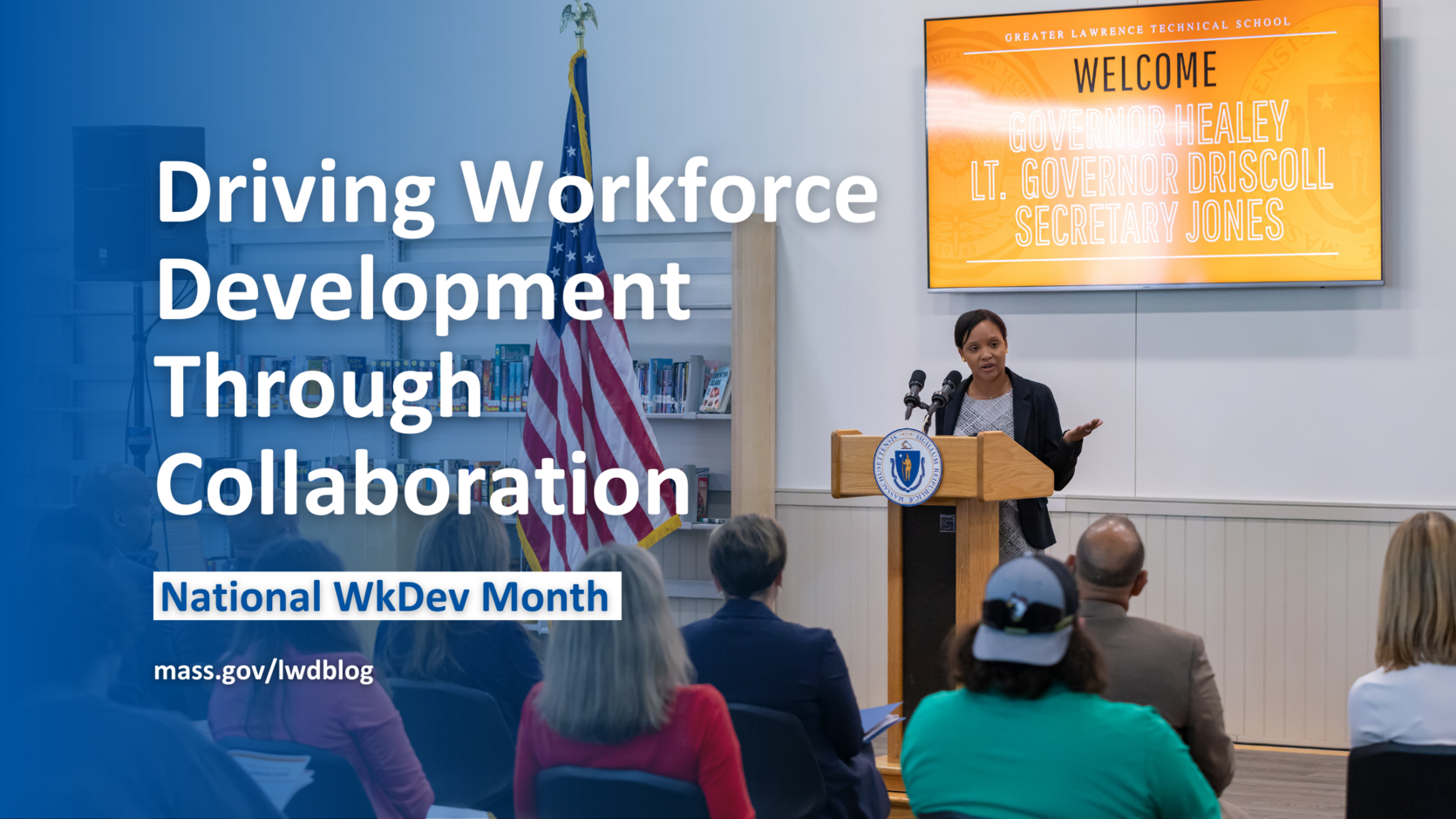- Executive Office of Labor and Workforce Development

As the Executive Office of Labor and Workforce Development (EOLWD) recognizes “National Workforce Development Month,” we also value the significant collaboration across state government and in partnership with local and regional organizations statewide to deliver meaningful programs that support our workers, jobseekers, and employers. The Healey-Driscoll Administration has emphasized the value of teamwork, and this is a recipe for success as we focus on workforce development strategies in Massachusetts. It takes teamwork across state government to foster coordination and deliver quality training to power the pipeline of skilled workers to strengthen Massachusetts’ economic prosperity today and for the future.
Partnerships Matter
Upon coming into office, the Healey-Driscoll Administration continued to convene the Workforce Skills Cabinet (WSC), bringing together the Executive Offices of Education (EOE), Economic Development (EOED), and EOLWD and expanded this group to include the Executive Office of Health and Human Services (HHS). Together, the WSC administers workforce development programs that upskill unemployed and underserved individuals for long-term prosperity and help businesses build a pipeline of skilled employees.
Despite historically low unemployment currently trending in Massachusetts, we recognize that workforce challenges persist across the state and impact large and small businesses. The WSC is working as a team to close the workforce skills gap, invest in workforce development resources for industries facing workforce shortages or that are growing, and re-engage the underemployed and discouraged individuals who have exited the labor market. In the early months of a new administration, the WSC is especially focusing on four key priority areas:
- Reimagine K-12 strategies including at the high school level to connect students to meaningful pathways for both college and career;
- Establish and launch MassReconnect to provide free community college as a workforce tool for adults 25 years or older without a college degree or credential;
- Strengthen pipelines for immigrants in Massachusetts, from international talent with credentials earned outside of the US to new arrivals seeking training and employment opportunities; and
- Leverage state funding and resources to build a robust pipeline of talent for high-growth industries in Massachusetts like health care and human services, clean energy, advanced manufacturing, and the life sciences.
Moreover, since January 2023, EOLWD has awarded more than $$40 million through programs like YouthWorks, Re-Entry, and Kenneth J. Donnelly Success Grants to increase access to high-quality job training, provide on-the-job training for individuals re-entering the workforce after incarceration, and introduce young workers to career pathways. Each of these dollars is lifting up training programs in direct collaboration with regional workforce boards, academic institutions, training providers, local hiring partners, and more—none of which could happen without teamwork driven by local and regional workforce partners. For example, $3.5 million in Workforce Success Grants through the Workforce Competitiveness Trust Fund (WCTF) is currently funding seven initiatives across the state with a collective goal of training over 450 unemployed and underemployed individuals in careers such as Medical Assistants, Certified Nursing Assistants, Home Health Aides, culinary, hospitality, and more.
Beyond EOLWD, Massachusetts is making workforce investments in areas that align with the WSC, administration priorities, and industry demands. For example, over the first several months as a new administration, Massachusetts has also invested $18 million in grants to drive equitable clean energy workforce development, $140 million in relief for nearly 3,000 primary care and behavioral health providers, and $2.5 million to expand green job training in Massachusetts. Additionally, the administration has expanded early college programs across the Commonwealth to students allowing students to get a head start on their professional development. This is just a snapshot of the work underway, and we know there are more opportunities ahead to tap effective, innovative programs to measure and make a difference.
One-stop Resources
MassHire is a “front door” to resources that have proven to be an incredible asset to connect employers, jobseekers, and training providers and leverage economic opportunity in local communities. Represented by 29 career centers and 16 regional workforce boards, MassHire delivers universal access, providing services to individuals and businesses. The MassHire system served more than 72,000 jobseekers and over 19,000 businesses in Fiscal Year 2022; since January of 2023, MassHire has served 87,040 jobseekers and more than 12,828 businesses. Among the greatest share of workers served by MassHire are people of color, demographics historically underrepresented in the labor force, with higher unemployment rates, and populations we want to connect to in-demand careers available in Massachusetts.
Planning for the Future
EOLWD embraces teamwork as we embark on the state’s workforce development plan. Like states across the country, our team partners with USDOL to file a strategic workforce plan, and we see this also as a critical opportunity to set a workforce agenda to prioritize opportunities and address challenges that will position the Commonwealth for economic growth, equity, and competitiveness five to ten years from now. Building on the team collaboration across state agencies, we are extending our reach to engage with academia, labor, employers and business groups, and regional workforce partners in the coming weeks—feedback will help inform our state planning efforts with the goal of filing a plan with the USDOL by the late winter 2024.
We look forward to continuing our collaboration with state government partners and local and regional workforce partners to attract, retain, and develop diverse talent across the Commonwealth. By implementing new workforce development strategies, Massachusetts workers and jobseekers benefit from expanded access to career advancement and upward mobility. Employers of all sizes, in all sectors, can attract, train, retain, and advance skilled workers, leading to a more engaged workforce, improved operations, and a better bottom line. So, let’s celebrate National Workforce Development Month throughout September, and let’s not lose sight of the valuable partnerships and teamwork it takes to fuel a thriving workforce for local communities and regional economies across the Commonwealth.
